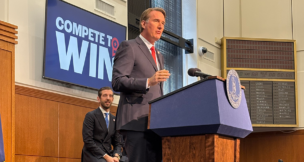Va. sees 5K spike in initial jobless claims last week
Since January, more than 1 million Virginians have filed initial jobless claims, according to the Virginia Employment Commission. More than 37,000 Virginians filed initial jobless claims last week — an increase of more than 5,000 claims from the previous week, according to a VEC statement released Thursday. “The jump in initial unemployment claims in Virginia […]
1M+ Virginians have filed jobless claims since January
Since January, more than 1 million Virginians have filed initial jobless claims, according to the Virginia Employment Commission. More than 32,000 Virginians filed initial jobless claims last week, according to a VEC statement released Thursday. The week before last, Virginia had the fourth-highest increase in initial jobless claims in the nation, but that was not […]
Va. among highest in nation for jobless claims last week
Virginia had the fourth-highest increase in initial jobless claims in the nation last week, according to U.S. Department of Labor (DOL) statistics released Thursday. The DOL statistics released Thursday morning shows that 33,069 Virginians filed initial jobless claims last week, while the VEC report released Thursday afternoon shows 31,825 initial claims. The DOL count is […]
366K+ Virginians remain jobless
More than 366,000 Virginians are still unemployed following the economic fallout from the COVID-19 pandemic, and initial jobless claims rose by more than 6,000 last week. The Virginia Employment Commission (VEC) announced Thursday that 906,734 people have filed initial unemployment claims since March 15. Nearly 32,000 Virginians filed initial claims last week, an increase of […]
Virginia Employment Commission closes HQ due to COVID-19
The Virginia Employment Commission is temporarily closing its Richmond headquarters office after the fourth VEC employee in three months has tested positive for COVID-19, the VEC announced Tuesday. The closure affects 350 employees who work out of the Richmond office. VEC call centers and district offices have not been affected and will continue to process […]
Community colleges, businesses partner to get Virginians back to work
The Virginia Ready Initiative (VA Ready) announced Monday a program that will provide stipends for unemployed Virginians to attend community college programs in an effort to find new industry jobs and overcome coronavirus-related economic hardships. “We have people who need work and companies who need employees, so Virginia’s community colleges and employers are coming together [&helli[...]
375K+ remain unemployed in Va. during pandemic
More than 375,000 Virginians are still unemployed following the economic fallout from the COVID-19 pandemic, though the number of initial jobless claims across the commonwealth continues to decrease. The Virginia Employment Commission (VEC) announced Thursday that 874,779 people have filed initial unemployment claims since March 15. However, the total of initial claims for the week […]
VCU-Ariz. State survey shows increased labor market activity
As states have begun to reopen for business, the national labor market has seen an increase in activity during the past two weeks, according to a biweekly survey conducted by Virginia Commonwealth University and Arizona State University economists. However, the 2.3% decrease in the national unemployment rate (which was estimated at 19.4% for the week […]
12K+ Virginians refuse to return to work amid pandemic
More than 12,000 Virginians who have filed jobless claims during the pandemic have refused to return to work, the Virginia Employment Commission announced Friday, while there are approximately 400,000 job vacancies posted on the Virginia Workforce Connection website. “While certain circumstances, such as health, child care or other caregiver responsibilities, may warrant continued payments of [&[...]
386K+ remain unemployed in Va. during pandemic
UPDATED 4 P.M. FRIDAY | More than 386,000 Virginians are still unemployed following the economic fallout from the COVID-19 pandemic, though the number of initial jobless claims across the commonwealth continues to decrease. The Virginia Employment Commission (VEC) announced Thursday that 849,486 initial unemployment claims have been filed since March 15. Virginia’s seasonally adjusted unempl[...]
Va. launches platform to connect people to jobs, education
With more than 400,000 Virginians unemployed, the state has launched a platform designed to connect people to educational and work opportunities broken down by region, Gov. Ralph Northam announced Friday. The Virginia Career Works Referral Portal connects people to training, certification, education and employment services to aid in job search and career development. Users can […]
396K+ Virginians remain unemployed during pandemic
Nearly 400,000 Virginians are still unemployed following the economic fallout from the COVID-19 pandemic, though the number of initial jobless claims across the commonwealth continues to decrease. The Virginia Employment Commission (VEC) announced Thursday that 822,300 initial unemployment claims have been filed since March 15, with approximately 75% of these claims having been approved and [&hell[...]














